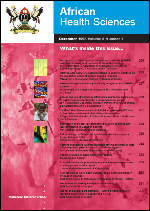
|
African Health Sciences
Makerere University Medical School
ISSN: 1680-6905
EISSN: 1680-6905
Vol. 13, No. 1, 2013, pp. 122-128
|
 Bioline Code: hs13020
Bioline Code: hs13020
Full paper language: English
Document type: Research Article
Document available free of charge
|
|
|
African Health Sciences, Vol. 13, No. 1, 2013, pp. 122-128
| en |
Acute organo-phosphorus pesticide poisoning in North Karnataka, India: oxidative damage, haemoglobin level and total leukocyte
Hundekari, IA; Suryakar, AN & Rathi, DB
Abstract
Background: Pesticide poisoning is an important cause of morbidity and mortality in India.
Objective:To assess the oxidative damage, hemoglobin level and leukocyte count in acute organophosphorus pesticide
poisoning.
Methods:Plasma cholinesterase was assessed as a toxicity marker. Oxidative damage was assessed by estimating serum
malondialdehyde (MDA) levels, plasma total antioxidant capacity (TAC), erythrocyte superoxide dismutase (SOD), catalase
(CAT) and glutathione peroxidase (GPx) levels.
Results:Progressive and significant decline (p< 0.001) in plasma cholinesterase in correlation with the severity of
organophosphorus poisoning was observed. Serum MDA levels significantly increased (p< 0.001) in all grades of
organophosphorus poisoning cases as compared to controls. Erythrocyte SOD, CAT and GPx were significantly increased
(p<0.05) in earlier grade and (p<0.001) in later grades of organophosphorus poisoning cases as compared to controls.
While plasma TAC (p<0.001) was significantly decreased in all grades of organophosphorus poisoning cases as compared
to controls.
Leucocytosis observed in these cases signifies the activation of defense mechanism which could be a positive response for
survival.
Conclusion:Organophosphorus compounds inhibit cholinesterase action leading to cholinergic hyperactivity. Increased
MDA level may lead to peroxidative damages deteriorating the structural and functional integrity of neuronal membrane.
Increased erythrocyte SOD, CAT and GPx activities suggest an adaptive measure to tackle the pesticide accumulation. Hence
it is concluded that cholinesterase inhibition may initiate cellular dysfunction leading to acetylcholine induced oxidative
damage.
|
| |
© Copyright 2012 - African Health Sciences
|
|
